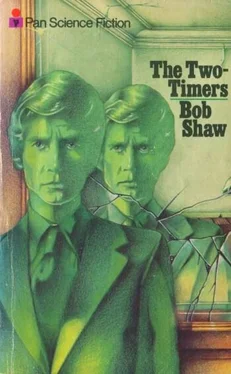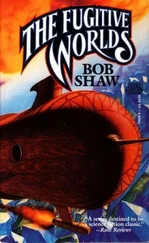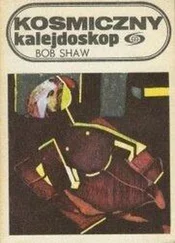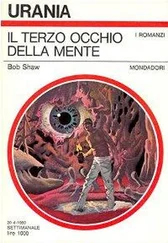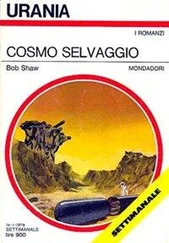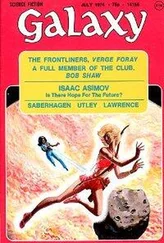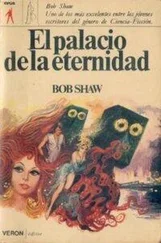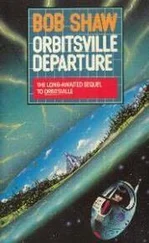Bob Shaw - The Two Timers
Здесь есть возможность читать онлайн «Bob Shaw - The Two Timers» весь текст электронной книги совершенно бесплатно (целиком полную версию без сокращений). В некоторых случаях можно слушать аудио, скачать через торрент в формате fb2 и присутствует краткое содержание. Год выпуска: 1971, Издательство: Pan SF, Жанр: Фантастика и фэнтези, на английском языке. Описание произведения, (предисловие) а так же отзывы посетителей доступны на портале библиотеки ЛибКат.
- Название:The Two Timers
- Автор:
- Издательство:Pan SF
- Жанр:
- Год:1971
- ISBN:нет данных
- Рейтинг книги:5 / 5. Голосов: 1
-
Избранное:Добавить в избранное
- Отзывы:
-
Ваша оценка:
- 100
- 1
- 2
- 3
- 4
- 5
The Two Timers: краткое содержание, описание и аннотация
Предлагаем к чтению аннотацию, описание, краткое содержание или предисловие (зависит от того, что написал сам автор книги «The Two Timers»). Если вы не нашли необходимую информацию о книге — напишите в комментариях, мы постараемся отыскать её.
THE TWO-TIMERS is his third novel, but the first to achieve maior publication.
The Two Timers — читать онлайн бесплатно полную книгу (весь текст) целиком
Ниже представлен текст книги, разбитый по страницам. Система сохранения места последней прочитанной страницы, позволяет с удобством читать онлайн бесплатно книгу «The Two Timers», без необходимости каждый раз заново искать на чём Вы остановились. Поставьте закладку, и сможете в любой момент перейти на страницу, на которой закончили чтение.
Интервал:
Закладка:
Abruptly, several of the fluffy balls sprang up within a radius of fifty paces, making him snatch for breath. Summoning his presence of mind, he kept his gaze fixed on the spot where the nearest materialization had taken place. Larmour reached the place, laboring with his inexpert low-gravity shuffle, and his gingery brows knit together as he saw there was no hole which could possibly contain the furtive gray entity he was seeking.
He knelt down to alter the direction of the light rays reflecting from the dust, and thought he could discern a shallow, dish-shaped depression with a minute dimple in the center. Becoming more and more puzzled, Larmour gently scooped the dust away with his hands until he had exposed the surface of the rock three inches below. There was a neat circular hole of about an inch diameter, looking as though it had been put there with a masonry drill. He pushed one finger into the hole, then jerked it out again as heat seared through the insulation of his glove. The surrounding rock was practically red hot.
Larmour sat back on his heels and stared at the black circle in perplexity. His mind was wrestling unsuccessfully with the problem it represented, when another gray ball appeared momentarily only a few feet away. This time he felt the ground tremors, and then suddenly he had the answer — the hideous, deadly answer.
On the Moon — with no air to buoy up its separate particles — a cloud of dust remains small and compact, and vanishes back into the ground almost as quickly as the eye can follow. And the only thing which would kick up such a cloud, human agencies excepted, was a meteor impact!
Larmour had left the safety of his vehicle and was walking about unprotected amid a meteor shower of unprecedented intensity, a hail of bullets fired a billion blind years earlier. Groaning at his own stupidity and lack of experience, he stood up and ran with ballooning Moon-steps towards the waiting crawler.
An obsolescent, four-engined aircraft was patiently clawing its way across the night skies of Northern Greenland. Inside its drumming, cylindrical belly, Denis Soderman carefully tended his banks of recording equipment, occasionally adjusting verniers, keeping the research plane’s inhuman and far-reaching senses at their keenest. He worked with the abstracted efficiency of a man who knows his job is important but who believes he was cut out for higher things.
Some distance forward of Soderman’s station, the senior — Dr. Cosgrove — sat at a makeshift desk, running gray paper tape though his hands like a tailor measuring cloth. His still-young face looked old and tired in the clinical light from the overhead tube.
“We don’t need to wait for a computer to process this lot, Denis,” Cosgrove said. “The solar corpuscular streams are obviously boosted way beyond normal. I’ve never seen readings like this, even with freak sunspot activity. The Van Allen belt must be soaking the stuff up like a sponge, and with those reports of fluctuations in the solar constant we got today from M.I.T., it looks…”
Denis Soderman stopped listening. He was adept at shutting out the older man’s ruminative voice, but this time it was more than a mere defense mechanism against the effects of unbridled pedantry. Something had happened to the aircraft. Seated far back from the machine’s center of gravity, Soderman had experienced a subtle, queasy corkscrewing motion. It had lasted perhaps half a second, but Soderman was a talented amateur pilot and had found something disturbing in the idea of a hundred-ton aircraft flicking its tail like a salmon. Emulating his electronic charges, he spread the network of his senses as wide as possible. For a few seconds he picked up nothing but the normal sensations of flight, then it happened again — a momentary lift and twist which made his stomach contract in alarm.
“They’re having trouble up front,” he said. “I don’t like the way this old bus is flying.”
Cosgrove looked up from his perforated streamers. “I didn’t feel anything.” His voice registered disapproval of Soderman’s lack of concentration on the job at hand.
“Listen, doctor. I’m way out on a limb here in the tail and I can feel — “
He broke off as the aircraft suddenly lurched sideways, shuddered, righted itself and became ominously quiet as all four engines cut out at the same time. Soderman, who had been lifted out of his seat and smashed against his instrument arrays, struggled to his feet and ran forward past Dr. Cosgrove. There was a noticeable slope in the gangway, showing that the aircraft was now flying in a pronounced nose-down attitude. A gray-faced second officer collided with him in the doorway to the flight deck.
“Get up to the tail and get your backs against the lavatory bulkhead! We’re going down!” The officer made no attempt to keep the panic out of his voice.
“Going down?” Soderman shouted. “Going down where? There isn’t a field within three hundred miles.”
“Are you telling me there’s no field?”
Even in a crisis the airman was jealous of his superiority over ordinary mortals, resentful at having to discuss the affairs of his aerial domain with an outsider.
“We’re doing everything we can to restart the engines, but Captain Isaacs isn’t optimistic. It looks as though he’ll have to try setting us down on the snow. Now will you go aft?”
“But it’s dark out there! Nobody could put a ship down — “
“That’s our problem, mister.” The officer pushed Soderman up the swaying gangway and turned back to the flight deck. Soderman’s mouth was dry as he moved aft, following the stumbling figure of Dr. Cosgrove.
They reached the conical tail-section and sat on the floor, backs braced against the cool metal of a major bulkhead. This far from the center of gravity each control movement made by the pilot was felt as a great, wild swing which gave Soderman the conviction the final catastrophe had arrived. With no sound from the engines to mask it, the passage of the fuselage through the air was loud, variable, menacing — the gleeful voice of a sky which could feel an enemy’s strength bleeding away.
Soderman tried to reconcile himself to the thought of dying within a matter of minutes, knowing that no combination of luck, pilot’s skill and structural integrity could enable the aircraft to survive contact with the earth. In daylight, or even in moonlight, it might have worked, but in pitch blackness there could be only one outcome to this rushing descent.
He clenched his teeth and vowed to go out with at least as much dignity as Dr. Cosgrove seemed to have mustered — but, when the impact came, he screamed. His voice was lost in a prolonged metallic thunderclap, then the plane was airborne again in a crazy, slewing leap, culminating in another incredible blast of sound which was compounded by the clattering of moveable objects bounding the length of the fuselage. The nightmare seemed to last for an eternity, during which all the interior lights were extinguished, but it ended abruptly, and Soderman discovered he was still breathing — miraculously, impossibly alive.
A few minutes later he was standing at an emergency door peering into the night sky at the glowing face of his savior.
Striated curtains of red and green light shimmered and danced from horizon to horizon, illuminating the snowscape below with an eerie, theatrical brilliance. It was an auroral display of supernatural intensity.
“This illustrates what I was saying about the Van Allen belt being overloaded,” Dr. Cosgrove commented emotionlessly behind Soderman. “The solar corpuscular stream is washing the upper atmosphere with charged particles which are draining into the magnetic poles. Their display, to which it seems we owe our lives, is only one facet of…”
Читать дальшеИнтервал:
Закладка:
Похожие книги на «The Two Timers»
Представляем Вашему вниманию похожие книги на «The Two Timers» списком для выбора. Мы отобрали схожую по названию и смыслу литературу в надежде предоставить читателям больше вариантов отыскать новые, интересные, ещё непрочитанные произведения.
Обсуждение, отзывы о книге «The Two Timers» и просто собственные мнения читателей. Оставьте ваши комментарии, напишите, что Вы думаете о произведении, его смысле или главных героях. Укажите что конкретно понравилось, а что нет, и почему Вы так считаете.
